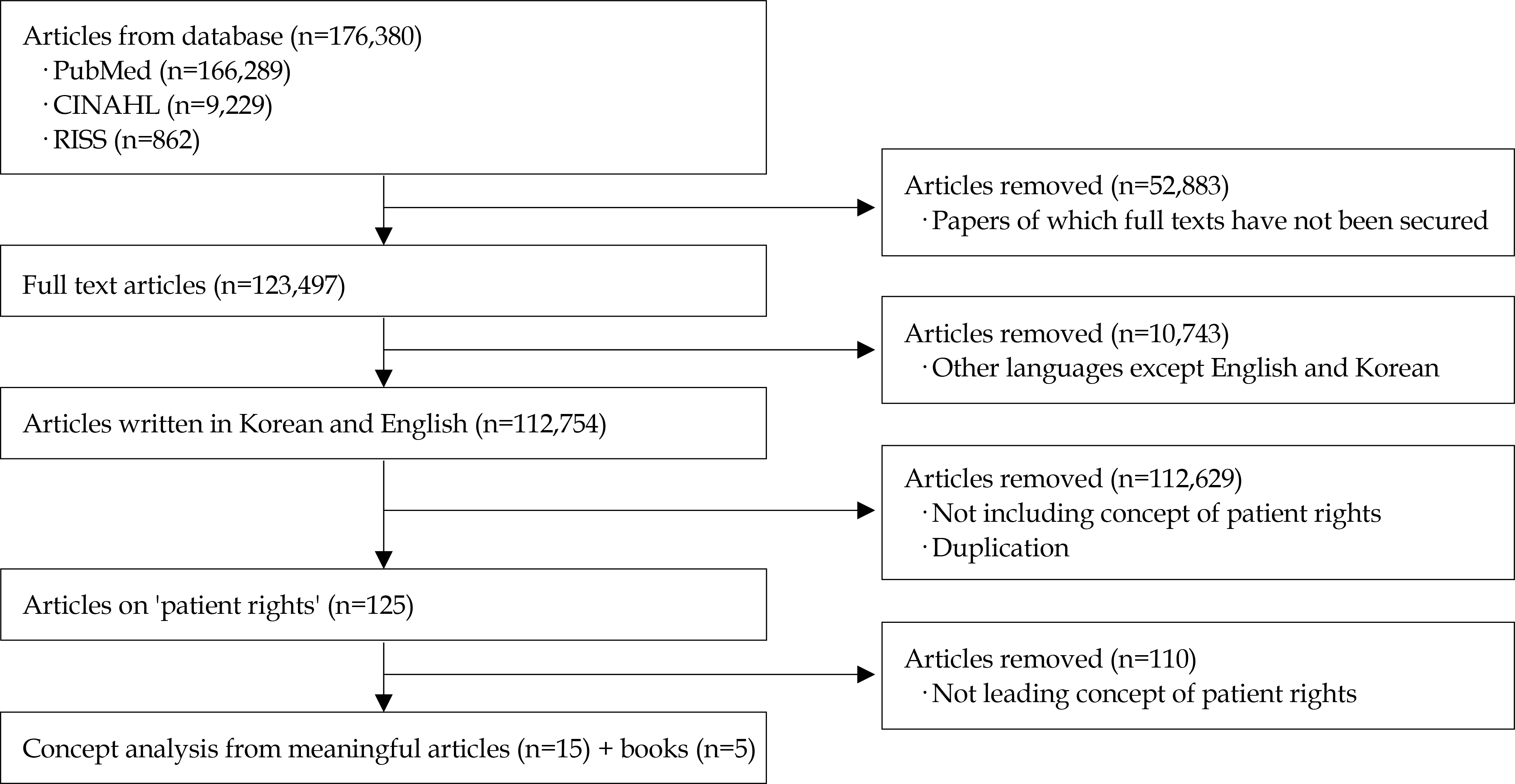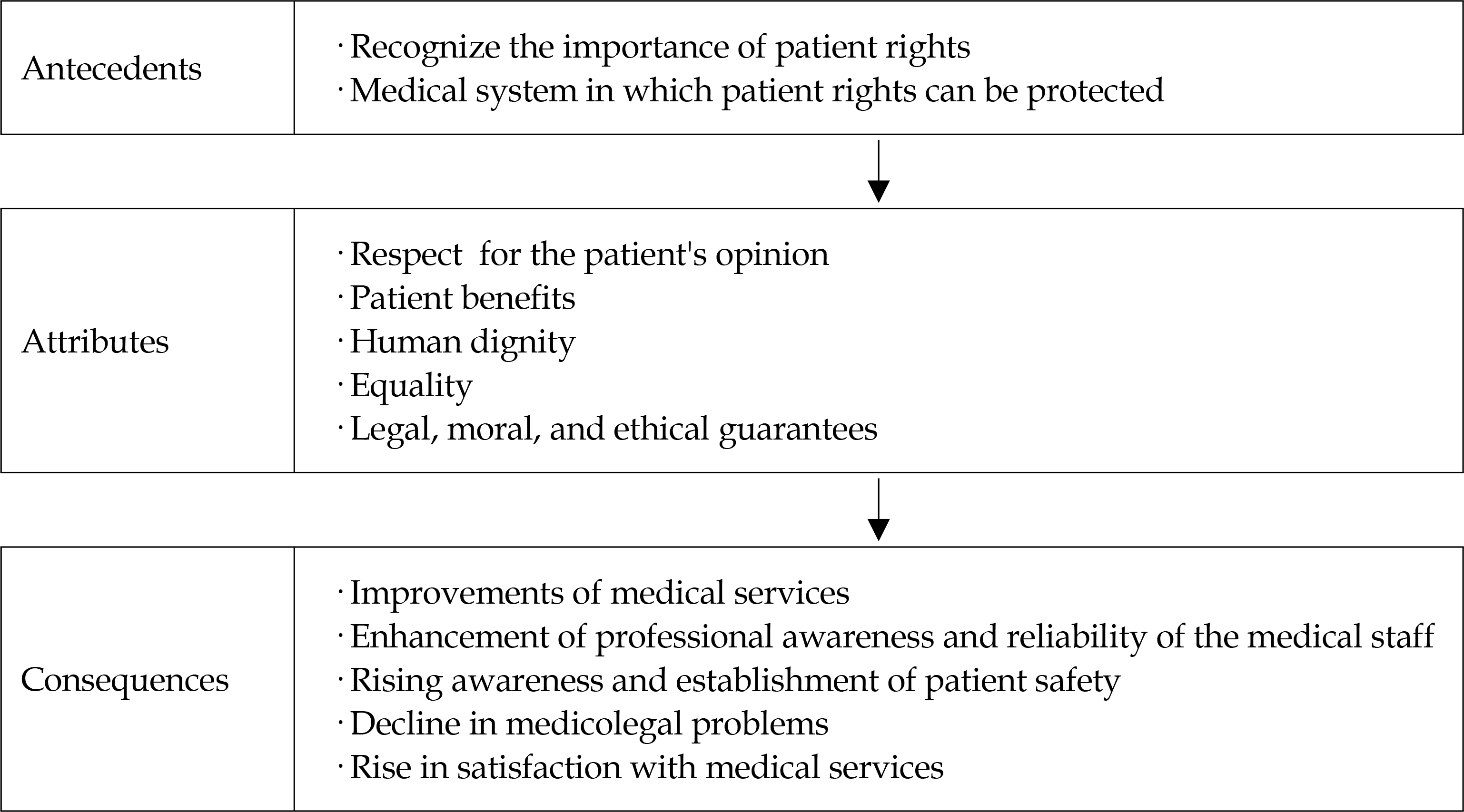Abstract
Methods
A concept analysis on patient rights through the concept analysis method proposed by Walker and Avant was conducted.
Results
The attributes of the concept identified in this study are as follows: (1) respect for the patient's opinion, (2) patient benefits, (3) human dignity, (4) equality, and (5) legal, moral, and ethical guarantees. The antecedents of patient rights include the recognition of the importance of patient rights and a medical system in which patient rights can be protected. Regarding the consequences of patient rights, this study identified the improvement of medical services, enhancement of professional awareness and reliability of medical staff, increase in awareness and establishment of patient safety, decline in medicolegal problems, and increase in satisfaction with medical services.
Conclusion
This study aimed to clarify the concept and attributes of patient rights through a concept analysis, and to connect the same to practical work to enable useful application to nursing practice. In determining the attributes of patient rights through a concept analysis, the study hoped to contribute to research on nursing intervention and the development of tools, as well as the establishment and implementation of legal systems related to patient rights.
REFERENCES
1. Lee HJ. Informed consent and the legal and ethical issue of autonomy. Kangwon Law Review. 2014; 42:347–80. https://doi.org/10.18215/kwlr.2014.42..347.
2. Kim YM. The relation of human dignity to rights-in comparison with Kant's and Hohfeld's rights theory-. Korean Journal of Legal Philosophy. 2006; 9(2):257–88.
3. The institute of Korean language dictionary. Kyohak Korean language dictionary. 5th ed. Seoul: Kyohaksa;2018. p. 258–60.
4. Lee CS. Social welfare concise. Gyeonggido Goyang: Haemin-books;;2013. p. 865.
5. Kim CW. A study on awareness of differences in importance and implementation of patients' rights [master's thesis]. Kang-wondo: Kangwon National University;2015.
6. Son Y-W. Study on the medical litigation and substantial protection of patients' rights. Han Yang Law Review. 2016; 27(2):191–211.
7. Kim KY. A reflection on the patients' rights act (RegE PatRG) in Germany. Korean Journal of Medicine and Law. 2012; 20(2):295–317.
8. Yi JK. A review on the patients' right protection and legislation of medical contract. Legal Research. 2014; 53:83–107.
9. Y JG. A criminal legal study in the protecting the right of surgical patients- self-determination of patients-. The Korean Society of Law and Medicine. 2015; 16(2):3–26.
10. Lauren Alloy. Counseling ethics: patients' rights. Counselling and Sermon. 2011. 103–13.
11. Suk HT. Patient's 'right not to know' and physician's 'duty to consideration'. The Korean Society of Law and Medicine. 2016; 17(2):145–73.
12. Hwang JY, Choi HK. Nursing students' human rights sensitivity and perception of patients' rights. The Journal of Korean Academic Society of Nursing Education. 2015; 21(4):454–64. https://doi.org/10.5977/jkasne.2015.21.4.455.

13. Jung Y. Compare patient right and consumer right in medical field. Health Policy and Management. 2017; 27(1):3–17. https://doi.org/10.4332/KJHPA.2017.27.1.3.
14. Um YR. A study on the concept of the patients' and the nurses' rights. The Korean Central Journal of Medicine. 1990; 55(7):461–70.
15. Choe NH. Patient's right and autonomy of nursing. The Korean Nurse. 1993; 32(5):50–4.
16. Jang IO. A study of professional nursing and patient's rights. Journal-Suncheon Cheong-am College. 1998; 22(1):1–32.
17. Yi M, Lee SW, Kim K, Kim M, Kim J, Lee K, et al. A review study on the strategies for concept analysis. Journal of Korean Academy of Nursing. 2006; 36(3):493–502. https://doi.org/10.4040/jkan.2006.36.3.493.

18. Walker LO, Avant KC. Strategies for theory construction in nursing. 5th ed.Upper Saddle River, NJ: Prentice Hall;2011. p. 1–243.
19. Chun CY. Studying quality of nursing. The Korean Nurse. 1980; 19(4):60–8.
20. Longman (EDT). Longman dictionary of contemporary engli-sh. 6th ed.Harlow: Pearson Education;2014.
21. Choi B-C. In pursuit of the concept of rights-Comparison between will theory and interest theory. Korean Journal of Legal Philosophy. 2003; 6(1):51–78.
22. Yoon CH. An investigation on Jhering's concept of right. Civil Case Law. 2007; 38:539–74.
23. Kim JY. A Study on the concept of "right" in constitutional law-an ordinary-language-analysis-based approach to legal concepts-. World Constitutional Law Review. 2016; 22(1):77–106.
24. Kim BJ, Choi BM, Choi IH, Jeon SJ. Law and society (high school). Seoul: Kyohaksa;2012. p. 30.
25. Lee SH. Is there a concept of ‘ right' in confucius ethics? Philosophy. 1996; 49:59–84.
26. Pastoral Institute of The Catholic University. A sketch on the right of patients. Pastoral study. 1996; 3:262–8.
27. Ryu HS, Kwon YC, Kim NH, Kim MH, Kim SD, Kim YH, et al. Laws related to health and medicine for nurse. Gyeonggido: Soomoonsa;2017. p. 25–272.
28. World Health Organization. Patients' rights [Internet]. Geneva: World Health Organization;2017. [cited 2017 November 15]. Available from:. http://www.who.int/genomics/public/patientrights/en/.
29. Korean Nurses Association. Florence Nightingale pledge [Internet]. Seoul: Korean Nurses Association;1988. [cited 2019 January 7]. Available from:. http://www.koreanurse.or.kr/about_KNA/nightingale.php.
30. Korean Nurses Association. The code of nurses ethics for Korean nurses [Internet]. Seoul: Korean Nurses Association;2013. [cited 2019 January 7]. Available from:. http://www.koreanurse.or.kr/about_KNA/ethics.php.
31. Hwang EA. The awareness of medical consumers and political implications as reported in the 「 consumption life indicators in Korea」. Policy Trend of Monthly Consumers. 2014; 54:14–39.
32. Lee H. Healthcare service consumer's perception of patient safety-relationship between perception of patient safety, right to know and self-determination [master's thesis]. Seoul: Yon-sei University;2016.
33. Lee IK. Limitation of the patient's autonomy. Personalism Bioethics. 2016; 6(1):75–105.
34. Sung NI. Constitutional law. Gyeonggido: Pubmoonsa;2014. p. 997.
35. Lee SS. A plea for a right to die with dignity. Studies on Life and Culture. 2013; 27:277–308.
Table 1.
List of Provisional Definitions for Patient Rights




 PDF
PDF ePub
ePub Citation
Citation Print
Print




 XML Download
XML Download